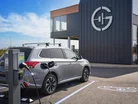Education and infrastructure, the keys to EV adoption

The electric vehicle (EV) industry has excelled in terms of battery range and charging facilities. The early adopters of electric witnessed the initial mains power method, by which they would plug their cars directly into a standard 240V socket. But, as range extends and more drivers want to take their EVs further—particularly as carmakers like Rivian and Lightyear promote the ability to take on new adventures through mobility—there is higher demand for roadside charging and dedicated power hubs.
Despite seeing a shift in sentiments towards electrification, advocates of fossil fuels compare the operation of EVs to a traditional model, whereby a car stops, fills up and leaves a station within five to 10 minutes. But the shift in power source creates a shift in mentality and, for many drivers, it’s a chance to be more sustainable and embrace a new way of life.
Historically, developments took place as a form of rapid response to the growing population, but also the changing economy. It cannot be stressed enough how urgently we must adapt to curb and reverse the effects of climate change and, with the transport industry accounting for around 25% to 30% of global greenhouse gas (GHG) emissions, there is no time for temporary actions influenced by the current landscape.
The effects of e-mobility are growing fast, but the real innovators are those that design and build the infrastructure required to make EVs truly sustainable. These are the charging infrastructure providers, the developers of public charging stations and, most recently, electric forecourts that showcase how a future without fossil fuels might look.
Do consumers know the ins and outs of EV?
Education is required in order to build a sustainable, electrified world, and it all starts with the battery.
As one of the more complex challenges in relation to traditional mobility, drivers have to really get to know their vehicles and how they work, including the effect different conditions will have on batteries. Those that are tech savvy tend to understand the technology, but others may need further explanation—soon, the days of fuel selection will enter the history books and everyone will need to understand the various electrical factors involved in charging their cars, right from the start of the buying process.
The ability of consumers to understand battery capacity and power output, as well as chargers and their varying rates of energy transfer, will determine the success of the switch from a century-old process of choosing between petrol and diesel. Convenience is another factor that plays into this as, at present, charging is not able to fulfil the same function as fuel stations across the board: charging times are longer and otherwise unreliable.
Cost being the lowest factor to prevent consumers from buying their first EV, the emphasis seems to be on infrastructure and the need for more charging solutions within the vicinity of their usual destinations. EY’s Mobility Consumer Index demonstrates this, with around 34% of its respondents being inhibited by the lack of charging stations along their travel routes or near their homes.
The next question for drivers is ‘where do I charge?’. A plethora of choice at different price points affects this decision, as does the type of charging infrastructure available—for example, some EV providers’ vehicles will only charge at bespoke facilities, limiting choice due to availability.
The rate at which companies are able to install public charging stations is also a determining factor in consumer efforts to make the switch. The common phrase we hear every day is ‘range anxiety’, which is induced by unreliable charging facilities, not to mention a lack thereof.
“The reliability of electricity supply is an issue in some markets, and unreliable electricity grids are obstacles to developing many kinds of infrastructure,” says Sam Clarke, Chief Vehicle Officer at GRIDSERVE.

